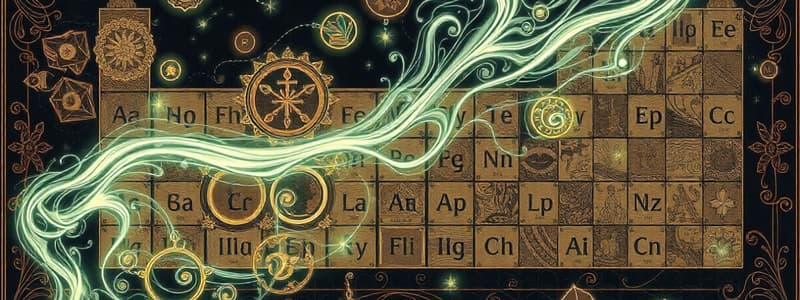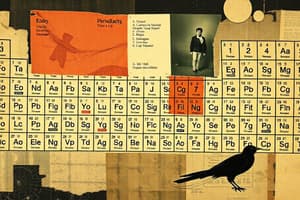Podcast
Questions and Answers
Which of the following elements is most likely to form an ion with a 2+ charge?
Which of the following elements is most likely to form an ion with a 2+ charge?
- Sodium (Na)
- Magnesium (Mg) (correct)
- Fluorine (F)
- Oxygen (O)
Based on the chart, which element is least likely to form a stable ion?
Based on the chart, which element is least likely to form a stable ion?
- Calcium (Ca)
- Chlorine (Cl)
- Nitrogen (N)
- Krypton (Kr) (correct)
What charge is typically associated with elements in Group 6A (VIA) when they form ions?
What charge is typically associated with elements in Group 6A (VIA) when they form ions?
- +2
- +1
- -1
- -2 (correct)
Considering the common charges, what is the most likely formula for a compound formed between Aluminum (Al) and Oxygen (O)?
Considering the common charges, what is the most likely formula for a compound formed between Aluminum (Al) and Oxygen (O)?
Which alkaline earth metal is located in the third period?
Which alkaline earth metal is located in the third period?
Which of the following elements is a halogen?
Which of the following elements is a halogen?
What is the expected ionic charge of Potassium (K)?
What is the expected ionic charge of Potassium (K)?
Which of these elements is a transition metal?
Which of these elements is a transition metal?
What is the compound formed when Barium (Ba) reacts with Oxygen (O)?
What is the compound formed when Barium (Ba) reacts with Oxygen (O)?
For which of the following pairs of elements would the compound formed most likely exhibit ionic bonding?
For which of the following pairs of elements would the compound formed most likely exhibit ionic bonding?
If element X is in Group 5A, what is the likely formula when it combines with Hydrogen?
If element X is in Group 5A, what is the likely formula when it combines with Hydrogen?
Which element readily forms diatomic molecules?
Which element readily forms diatomic molecules?
Which of the following elements has a full valence shell of electrons?
Which of the following elements has a full valence shell of electrons?
What is the correct formula for a compound formed between Calcium (Ca) and Phosphorus (P)?
What is the correct formula for a compound formed between Calcium (Ca) and Phosphorus (P)?
Which of the following elements is likely to have variable charges?
Which of the following elements is likely to have variable charges?
What charge is expected on a sulfide ion?
What charge is expected on a sulfide ion?
Which group of elements is known as the alkali metals?
Which group of elements is known as the alkali metals?
An element has an electron configuration ending in $ns^2np^4$. What charge would be most likely on its ion?
An element has an electron configuration ending in $ns^2np^4$. What charge would be most likely on its ion?
Element X is in the same group as oxygen. What is the predicted formula of the compound it forms with potassium?
Element X is in the same group as oxygen. What is the predicted formula of the compound it forms with potassium?
Flashcards
Group 1 Charge
Group 1 Charge
Elements in Group 1 of the periodic table (e.g., Hydrogen, Lithium, Sodium) typically have a charge of +1.
Group 2 Charge
Group 2 Charge
Elements in Group 2 of the periodic table (e.g., Beryllium, Magnesium) typically have a charge of +2.
Group 16 Charge
Group 16 Charge
Elements in Group 16 of the periodic table (e.g., Oxygen, Sulfur) typically have a charge of -2.
Group 17 Charge
Group 17 Charge
Signup and view all the flashcards
Ions
Ions
Signup and view all the flashcards
Variable Charges
Variable Charges
Signup and view all the flashcards
Group 13 Charge
Group 13 Charge
Signup and view all the flashcards
Study Notes
- Element charges are displayed on a periodic table
- The charges are 1+, 2+, variable, 3+, 4+/4-, 3-, 2-, 1- and 0
Element Groupings
- 1+ includes H, Li, Na, K, Rb, Cs, and Fr
- 2+ includes Be, Mg, Ca, Sr, Ba, and Ra
- Variable charges includes the transition metals: Sc, Ti, V, Cr, Mn, Fe, Co, Ni, Cu, Zn, Y, Zr, Nb, Mo, Tc, Ru, Rh, Pd, Ag, Cd, Hf, Ta, W, Re, Os, Ir, Pt, Au, Hg, Rf, Db, Sg, Bh, Hs, Mt, Ds, and Rg
- 3+ includes B, Al, Ga, and In
- 4+/4- includes C, Si, Ge, As, Sn, and Tb
- 3- includes N, P, and Bi
- 2- includes O, S, Se, Te, Po, and Lv
- 1- includes F, Cl, Br, I, At, and Ts
- 0 includes the Noble Gasses: He, Ne, Ar, Kr, Xe, Rn, and Og
Studying That Suits You
Use AI to generate personalized quizzes and flashcards to suit your learning preferences.




